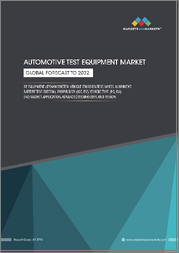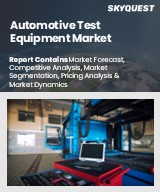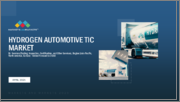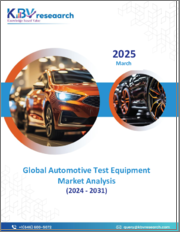
|
시장보고서
상품코드
1756026
세계의 자동차 시험 장비 시장 : 차량별, 제품별, 솔루션별, 지역별 기회 및 예측(2018-2032년)Global Automotive Test Equipment Market Assessment, By Vehicle Type, By Product Type, By Solution Type, By Region, Opportunities and Forecast, 2018-2032F |
||||||
세계의 자동차 시험 장비 시장 규모는 차량 개발, 제조 및 유지보수에 사용되는 도구 및 시스템의 사용이 증가로 2024년 32억 6,000만 달러에서 2032F년에는 49억 1,000만 달러로 성장할 것으로 예측되고 예측 기간 동안 CAGR 5.26%로 성장할 전망입니다.
이 시장은 생산 라인 장비, 진단 장비, 배기 가스 시험기 및 ADAS/EV 시험 시스템을 포함합니다. 성장은 기술 발전과 규제 의무에 의해 촉진되고 있습니다. 스마트 제조의 혁신과 EV 및 자율주행차의 채택이 증가함에 따라 엄격한 시험 체제가 필요하게 되었습니다. 이 산업은 세계의 시장의 안전, 환경 및 성능 기준의 진화에 대응하여 혁신, 전략적 파트너십 및 지역 확장에 주력하는 업체들이 경쟁을 벌이고 있습니다.
본 보고서에서는 세계의 자동차 시험 장비 시장을 조사했으며, 시장 정의와 개요, 시장 규모 추이와 예측, 각종 구분별 상세 분석, 사례연구, 시장성장에 대한 영향요인 분석, 경쟁 구도, 주요기업의 프로파일 등을 정리했습니다.
목차
제1장 프로젝트의 범위와 정의
제2장 조사 방법
제3장 미국 관세의 영향
제4장 주요 요약
제5장 고객의 목소리
- 응답자의 인구통계
- 브랜드 인지도
- 구매 결정 시 고려되는 요소
- 언멧 요구
제6장 세계의 자동차 시험 장비 시장 전망
- 시장 규모의 분석 및 예측
- 시장 점유율의 분석 및 예측
- 차량 유형별
- 승용차
- 상용차
- 제품 유형별
- 연기 측정기
- 투과도 측정기
- 기타
- 솔루션 유형별
- 배출가스 시험 장비
- 배출가스 시험 소프트웨어
- 배출가스 시험 서비스
- 지역별
- 북미
- 유럽
- 아시아태평양
- 남미
- 중동 및 아프리카
- 기업 점유율 분석
- 차량 유형별
- 시장 맵 분석
제7장 북미의 자동차 시험 장비 시장 전망
- 시장 규모의 분석 및 예측
- 시장 점유율의 분석 및 예측
- 국가별 시장 평가
- 캐나다
- 멕시코
제8장 유럽의 자동차 시험 장비 시장 전망
- 독일
- 프랑스
- 이탈리아
- 영국
- 러시아
- 네덜란드
- 스페인
- 튀르키예
- 폴란드
제9장 아시아태평양의 자동차 시험 장비 시장 전망
- 인도
- 중국
- 일본
- 호주
- 베트남
- 한국
- 인도네시아
- 필리핀
제10장 남미의 자동차 시험 장비 시장 전망
- 브라질
- 아르헨티나
제11장 중동 및 아프리카의 자동차 시험 장비 시장 전망
- 사우디아라비아
- UAE
- 남아프리카
제12장 Porter's Five Forces 분석
제13장 PESTLE 분석
제14장 시장 역학
- 시장 성장 촉진요인
- 시장의 과제
제15장 시장 동향과 발전
제16장 사례 연구
제17장 경쟁 구도
- 상위 5개사의 경쟁 매트릭스
- 상위 5개사의 SWOT 분석
- 주요 10개사의 정세
- Opus Group AB
- Gemco Equipment Ltd & Gemco Service Ltd
- TUV NORD GROUP
- CAPELEC SAS
- HORIBA, Ltd.
- Applus Servicios Tecnologicos, SLU
- Bosch Automotive Service Solutions LLC
- MTS Systems Corporation
- Huff Technologies Inc.
- Snap-on Equipment Srl
제18장 전략적 제안
제19장 기업 소개와 면책사항
HBR 25.07.04Global automotive test equipment market is projected to witness a CAGR of 5.26% during the forecast period 2025-2032, growing from USD 3.26 billion in 2024 to USD 4.91 billion in 2032F, owing to the increased usage of tools and systems used in vehicle development, manufacturing, and maintenance. It spans production-line equipment, diagnostic devices, emissions testers, and ADAS/EV test systems. Growth is driven by technological advancements and regulatory mandates. Innovation in smart manufacturing and the rising adoption of EVs and autonomous vehicles necessitate rigorous testing regimes. The industry is competitive, with players focusing on innovation, strategic partnerships, and regional expansion in response to evolving safety, environmental, and performance standards across global markets.
For instance, in July 2024, the TRUE Initiative launched Africa's first real-world vehicle emissions testing in Kampala, Uganda, using advanced plume-chasing technology to assess 4,000 vehicles. This project sets a new quality benchmark for emissions data, supporting stricter standards for imported used vehicles while empowering policymakers to improve air quality and public health in rapidly growing cities.
ADAS Proliferation Along with Compliance to Fuel the Automotive Test Equipment Market Demand
As electric vehicles and advanced driver-assistance systems become widespread, automakers demand specialized testing equipment-battery cyclers, thermal chambers, radar simulators, and on-road ADAS validation rigs to verify safety and performance. The complexity and integration of electronics and software heighten the need for precise, automated testing tools in R&D and production environments. This accelerates investment in innovative testing infrastructure to meet both consumer safety expectations and regulatory requirements.
For instance, in March 2023, AB Dynamics plc launched new ADAS/AV test equipment. Specifically engineered to replicate complex urban testing scenarios, the LaunchPad Spin mimics dynamic movements, accommodates various vulnerable road user (VRU) targets, and achieves a maximum speed of 30 km/h (20 mph). The Spin is equipped with torque vectoring wheels and a front wheel that is precision-steered, allowing for continuous rotation through 360 degrees without a stopping point.
Stringent global safety and environmental standards, such as Euro 7, EPA, NHTSA mandates, and similar across APAC, require intensive end-of-line and type-approval testing. Emissions analyzers, chassis dynamometers, and environmental simulators ensure vehicle fleets meet CO2, particulate, and crash standards. Enforcement pressure and imposing penalties drive OEMs and suppliers to upgrade testing capabilities, boosting equipment demand and compliance-driven market growth.
Industry 4.0 and Aftermarket Expansion to Shape Automotive Test Equipment Market Dynamics
The combination of IoT, digital twins, AI-powered predictive analytics, and cloud platforms is revolutionizing testing operations, turning them into smarter, data-driven processes. This upgrade boosts efficiency, improves traceability, and enhances predictive maintenance. Suppliers now offer modular, connected test benches and virtualization software, creating market demand for turnkey, Industry 4.0-ready solutions that support real-time decision-making and flexible production strategies.
For instance, in April 2024, AVL Group unveiled advanced test systems for brake emissions regulation compliance at the Automotive Testing Expo. The company's new brake particle analysis system is designed to help manufacturers meet stringent regulatory standards by providing precise measurement and analysis of brake emissions. This innovation highlights AVL's ongoing commitment to developing innovative automotive testing equipment that addresses evolving industry requirements and supports cleaner, safer mobility solutions.
The proliferation of vehicles and growing consumer awareness about proper maintenance, fuel demand for service-level diagnostic and repair tools. Independent workshops require portable scan tools, oscilloscopes, and wheel alignment testers. In emerging markets, the surge in fleets and ride-hailing services intensifies wear and tear diagnostics. This aftermarket ecosystem complements OEM production testing, extending demand into post-sale segments.
Passenger Vehicles Lead in the Global Automotive Test Equipment Market
Based on vehicle type, the passenger vehicle segment dominates owing to its sheer volume in global vehicle production. As OEMs ramp up annual car manufacturing, boosted by rising middle-class demand, urbanization, and fleet renewal, test-equipment requirements scale proportionally. Passenger cars also drive innovative trends; their transition to EVs, HEVs, and ADAS platforms make them frontline adopters of advanced testing rigs ranging from battery system cyclers to radar and LiDAR validation chambers.
Passenger vehicles face rigorous safety and emissions standards in major markets (EU, the U.S., China), necessitating extensive compliance checks. Manufacturers build high-throughput production testing lines tailored for mass-produced car models, while increasing complexity in infotainment, connectivity, and electrification widens the scope for diagnostics and subsystem testing. This bird's-eye combination of scale, regulation, and tech infusion ensures passenger vehicles remain the largest and fastest-growing segment in the test equipment industry.
Europe Dominates the Global Automotive Test Equipment Market Share
Europe is at the forefront of the global automotive test equipment market, owing to a mix of strict regulations, innovative technological advancements, and a strong automotive manufacturing sector. The region's early adoption of strict emission standards, such as Euro 6 and Euro 7, compels manufacturers to invest in innovative testing solutions to ensure compliance with environmental and safety regulations. Germany stands out as a leader in the automotive market, highlighting its strength through a robust automotive industry, heavy investments in research and development, and a commitment to both traditional and electric vehicles.
European automakers are focusing on quality assurance, making good use of advanced diagnostic tools and testing systems to check emissions, battery performance, and the latest in autonomous driving tech. Plus, with government incentives pushing for zero-emission vehicles and the growing popularity of electric and hybrid buses, there's a rising demand for cutting-edge testing equipment. Major industry players drive continual innovation, solidifying Europe's position as a benchmark for reliability, sustainability, and technological advancement in the global automotive test equipment sector.
For instance, in June 2023, UK-based Autocraft EV Solutions launched its REVIVE MOBILE Repair Centre at the REMATEC exhibition in Amsterdam. This pioneering facility, housed in a 30-foot expandable container, is fully equipped with advanced automotive testing equipment for EV battery diagnostics, integrity checks, and remanufacturing. Capable of servicing up to 2,000 battery packs annually, it delivers scalable, on-site battery testing and repair, reducing environmental impact and logistical challenges.
Impact of the U.S. Tariff on the Automotive Test Equipment Market
The U.S. tariffs on imported auto parts and testing equipment are driving up costs for OEMs and their suppliers. This situation forces them to either absorb the price hikes or move their production elsewhere. A hefty 25% tariff on auto components is putting pressure on smaller and mid-sized suppliers, pushing them to either shift their operations overseas or expand their product offerings. Meanwhile, larger companies are eyeing options in Vietnam, Mexico, or even expanding within the U.S. to dodge these tariffs. The increased import costs are also causing delays in investments for next gen testing systems and making it harder for equipment to stay competitively priced. Hence, OEMs are taking a hard look at their supply chains, leaning towards local sourcing, or setting up regional testing hubs to reduce tariff risks and stay compliant with regulations.
Key Players Landscape and Outlook
Market leaders are all about standing out with their products, and they do this by offering top-notch sensor portfolios that include MEMS, infrared, and non-contact technologies. They pour a lot of resources into research and development to make devices smaller, tougher, and better suited for the ever-changing needs of electric vehicles (EVs) and advanced driver-assistance systems (ADAS). By forming strategic partnerships and joint development agreements with automakers and semiconductor companies, they enhance their integration capabilities. Expanding their global manufacturing presence, especially in Asia-Pacific and North America, helps them minimize tariff risks and streamline their supply chains. On top of that, companies are stepping up their aftermarket services by providing IoT-enabled sensor solutions for remote diagnostics and predictive maintenance. With competitive pricing and a solid quality certification process, companies are securing wins with original equipment manufacturers (OEMs), all while ensuring their sourcing practices meet global emission and safety standards.
For instance, in October 2023, Opus Group AB unveiled a unified platform that encompasses OE and multi-brand diagnostics, remote programming, and calibration solutions, supported by skilled technicians and advanced patented technology. The company is pleased to present its newest innovative product, ADAS Map. This software platform is designed to thoroughly identify ADAS systems, their components, exact component locations, required calibrations, and the fundamental reasons for these calibrations.
Table of Contents
1. Project Scope and Definitions
2. Research Methodology
3. Impact of U.S. Tariffs
4. Executive Summary
5. Voice of Customers
- 5.1. Respondent Demographics
- 5.2. Brand Awareness
- 5.3. Factors Considered in Purchase Decisions
- 5.4. Unmet Needs
6. Global Automotive Test Equipment Market Outlook, 2018-2032F
- 6.1. Market Size Analysis & Forecast
- 6.1.1. By Value
- 6.2. Market Share Analysis & Forecast
- 6.2.1. By Vehicle Type
- 6.2.1.1. Passenger Vehicles
- 6.2.1.2. Commercial Vehicles
- 6.2.2. By Product Type
- 6.2.2.1. Smoke Meter
- 6.2.2.2. Opacity Meter
- 6.2.2.3. Others
- 6.2.3. By Solution Type
- 6.2.3.1. Emission Test Equipment
- 6.2.3.2. Emission Test Software
- 6.2.3.3. Emission Test Services
- 6.2.4. By Region
- 6.2.4.1. North America
- 6.2.4.2. Europe
- 6.2.4.3. Asia-Pacific
- 6.2.4.4. South America
- 6.2.4.5. Middle East and Africa
- 6.2.5. By Company Market Share Analysis (Top 5 Companies and Others - By Value, 2024)
- 6.2.1. By Vehicle Type
- 6.3. Market Map Analysis, 2024
- 6.3.1. By Vehicle Type
- 6.3.2. By Product Type
- 6.3.3. By Solution Type
- 6.3.4. By Region
7. North America Automotive Test Equipment Market Outlook, 2018-2032F
- 7.1. Market Size Analysis & Forecast
- 7.1.1. By Value
- 7.2. Market Share Analysis & Forecast
- 7.2.1. By Vehicle Type
- 7.2.1.1. Passenger Vehicles
- 7.2.1.2. Commercial Vehicles
- 7.2.2. By Product Type
- 7.2.2.1. Smoke Meter
- 7.2.2.2. Opacity Meter
- 7.2.2.3. Others
- 7.2.3. By Solution Type
- 7.2.3.1. Emission Test Equipment
- 7.2.3.2. Emission Test Software
- 7.2.3.3. Emission Test Services
- 7.2.4. By Country Share
- 7.2.4.1. United States
- 7.2.4.2. Canada
- 7.2.4.3. Mexico
- 7.2.1. By Vehicle Type
- 7.3. Country Market Assessment
- 7.3.1. United States Automotive Test Equipment Market Outlook, 2018-2032F*
- 7.3.1.1. Market Size Analysis & Forecast
- 7.3.1.1.1. By Value
- 7.3.1.2. Market Share Analysis & Forecast
- 7.3.1.2.1. By Vehicle Type
- 7.3.1.2.1.1. Passenger Vehicles
- 7.3.1.2.1.2. Commercial Vehicles
- 7.3.1.2.2. By Product Type
- 7.3.1.2.2.1. Smoke Meter
- 7.3.1.2.2.2. Opacity Meter
- 7.3.1.2.2.3. Others
- 7.3.1.2.3. By Solution Type
- 7.3.1.2.3.1. Emission Test Equipment
- 7.3.1.2.3.2. Emission Test Software
- 7.3.1.2.3.3. Emission Test Services
- 7.3.1.2.1. By Vehicle Type
- 7.3.1.1. Market Size Analysis & Forecast
- 7.3.2. Canada
- 7.3.3. Mexico
- 7.3.1. United States Automotive Test Equipment Market Outlook, 2018-2032F*
All segments will be provided for all regions and countries covered
8. Europe Automotive Test Equipment Market Outlook, 2018-2032F
- 8.1. Germany
- 8.2. France
- 8.3. Italy
- 8.4. United Kingdom
- 8.5. Russia
- 8.6. Netherlands
- 8.7. Spain
- 8.8. Turkey
- 8.9. Poland
9. Asia-Pacific Automotive Test Equipment Market Outlook, 2018-2032F
- 9.1. India
- 9.2. China
- 9.3. Japan
- 9.4. Australia
- 9.5. Vietnam
- 9.6. South Korea
- 9.7. Indonesia
- 9.8. Philippines
10. South America Automotive Test Equipment Market Outlook, 2018-2032F
- 10.1. Brazil
- 10.2. Argentina
11. Middle East and Africa Automotive Test Equipment Market Outlook, 2018-2032F
- 11.1. Saudi Arabia
- 11.2. UAE
- 11.3. South Africa
12. Porter's Five Forces Analysis
13. PESTLE Analysis
14. Market Dynamics
- 14.1. Market Drivers
- 14.2. Market Challenges
15. Market Trends and Developments
16. Case Studies
17. Competitive Landscape
- 17.1. Competition Matrix of Top 5 Market Leaders
- 17.2. SWOT Analysis for Top 5 Players
- 17.3. Key Players Landscape for Top 10 Market Players
- 17.3.1. Opus Group AB
- 17.3.1.1. Company Details
- 17.3.1.2. Key Management Personnel
- 17.3.1.3. Key Products Offered
- 17.3.1.4. Key Financials (As Reported)
- 17.3.1.5. Key Market Focus and Geographical Presence
- 17.3.1.6. Recent Developments/Collaborations/Partnerships/Mergers and Acquisitions
- 17.3.2. Gemco Equipment Ltd & Gemco Service Ltd
- 17.3.3. TUV NORD GROUP
- 17.3.4. CAPELEC SAS
- 17.3.5. HORIBA, Ltd.
- 17.3.6. Applus Servicios Tecnologicos, SLU
- 17.3.7. Bosch Automotive Service Solutions LLC
- 17.3.8. MTS Systems Corporation
- 17.3.9. Huff Technologies Inc.
- 17.3.10. Snap-on Equipment Srl
- 17.3.1. Opus Group AB
Companies mentioned above DO NOT hold any order as per market share and can be changed as per information available during research work.



















